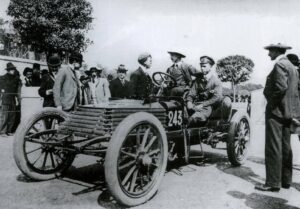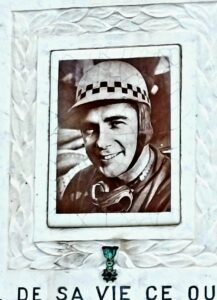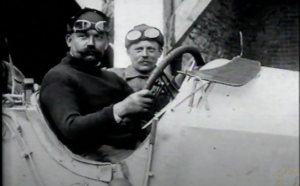
It’s curious how sport can diverge. Relatively straightforward sporting concepts, growing in different directions due to geography or arena. It can be difficult to reconcile different ‘codes’, different approaches. But, if possible, the result can be spectacular.
On Sunday 2nd April, 1899 – after 8 hours 22 minutes of racing, and seven falls – French track cyclist Albert Champion won the 4th edition of Paris-Roubaix… by 35 minutes. The success of his lone break made possible by the use of motorised pacesetters. This, a concession by the organisers to tease-out a battle between champions of the road and the vélodrome.

His success allowed Champion escape to America. Escape from conscription. Escape to the land of opportunity, with a track racing contract for 1900 in his back pocket. Soon, he was importing & racing French motorcycles. Then French automotive parts. Then in 1907, his own automotive manufacturing company in Boston. A bright spark, was that Champion!
As America’s wooden cycle tracks gradually turned into motor-racing venues in the early years of the 20th century, the Duesenberg brothers came to the fore. And as successful racing car & engine manufacturers, “The Kaiser War” would see them involved in the US war effort.
A contract was obtained for Duesenberg to manufacture aircraft engines under license. The engines in question were from the greatest European marques – Hispano Suiza and Bugatti. Duesenberg were particularly involved with the Bugatti project. A project overseen on Molsheim’s behalf by Ernest Friderich of Bugatti’s Nice dealership, and by Charles B. King of the U.S. Signals Corps.
There is much to say about Bugatti’s aero engines, his engineering myopia, and how the Americans changed his designs – but that is for another day. Let us just say that in 1920, after a couple of years developing Ettore Bugatti’s U-16 & Straight-8 concepts, Duesenberg designed themselves a 3-litre, straight-8 engine to meet the new international racing formula.
A straight-8 engine constructed with two blocks, each of four cylinders. A single overhead cam, shaft-driven from the crank, actuating two exhaust & one inlet valves. You could say that the Duesenberg Brothers had received a pur-sang transfusion!

Piece-by-piece the European sporting calendar returned after The Great War. Setting out to see if it was even possible to stage Paris-Roubaix in 1919, l’Auto reported, “We enter into the centre of the battlefield. There’s not a tree, everything is flattened! Not a square metre that has not been hurled upside down. There’s one shell hole after another. The only things that stand out in this churned earth are the crosses with their ribbons in blue, white and red. It is hell!”
While ‘The Hell of the North’ made its return, the Automobile Club de France took a little longer – needed to take some time – before reviving The Grand Prix. But eventually a date was set, Monday 25th July 1921, and the location chosen… Le Mans. Where else, for a re-birth?
Entries were open – to all except Mercédès and Benz – and the home of motorsport prepared to receive the faithful.
The proposed field looked interesting. STD opted to send seven identical cars, variously entered as ‘Sunbeam’, ‘Talbot’ and ‘Talbot-Darracq’. Édouard Ballot’s Henry-engined racers were the favourites – four new cars, and the determination that the race should be won ‘for France’.
Technically, the most interesting entry was from FIAT… of course. Three FIAT 802, with their new-concept engine, promised to be the most-powerful, highest-revving machine in the race. But it was not to be. The cars, not ready for July, would have to wait until the Coppa Florio to show their potential.
STD were struggling too to present all the cars they had had promised, so there was likely great relief at l’ACF when a cable from America arrived, just after entries had closed. It was from Fred Duesenberg. Albert Champion had agreed to sponsor a team through his spark plug brand. $60,000 to send four Duesenbergs to The Old Country – the fastest cars from the Indy 500 were set for the crumbling asphalt of La Sarthe.

Race week. Training underway… and the Duesenbergs are turning heads. Turning heads amongst the crowds – the pared-down, white machines looking every inch the 100mph Indy bullets. Turning heads in the paddock too – and not just because the new straight-8 more than matched Henry’s latest on power*. No, the talking point was how the Duesenberg could stop. Duesenberg knew they had to have four-wheel brakes to match the Ballot, but they had taken the next step. For the first time a racing car was fitted with hydraulic brakes on all four wheels. A ‘game changer’.
(* One wonders what Ettore Bugatti made of this new arrival, with its oh-so-familiar engine. Still, Bugatti had his hands full with voiturette racing – creating legend.)
Duesenberg drivers Jimmy Murphy and Louis Inghibert were quickly caught out by the powerful new brakes when sharing a car in practice. With most of the breaking on the rear, the Duesenberg had pitched off the road under heavy braking – the weight transferring forwards and the rear axle skipping on the rough road. Murphy & Inghibert found themselves through the ditch and underneath their machine.
As both men were patched up for their injuries – broken ribs & lacerations – Murphy’s riding mechanic, Ernie Olson, spotted the solution. He had observed that the Ballots ran smaller brakes on their back axle. Hacksaws quickly shortened the Duesenbergs’ rear brake shoes by two inches, and the team found the balance & stability they needed.
And so, on to the race. A 9am start, for 320 miles at La Sarthe.

Mathis (Mathis) & DePalma (Ballot) are first to be flagged-off… DePalma bolting away. The rest, following in pairs at one minute intervals. Flat-chat, straight all the way to the hairpin at Pontileue.
Tertre Rouge, les Hunaudieres, Mulsane, Indianapolis, Arnage, White House… here they come, and times are in! There’s nothing in it… after the first 10.7 mile lap, DePalma (Ballot) & Boyer (Duesenberg) are tied for the lead at 8min 16sec. Third place is also a tie, between Chassagne (Ballot) and Murphy, heavily bandaged at the wheel of his Duesenberg.
On to the second lap of thirty, and a pattern is starting to appear. Little to chose between the Ballot and the Duesenberg on raw power. The American cars taking huge amounts of time out of the Ballots under braking at Pontileue and Mulsanne. The French car able to carry more speed through the corners.
Murphy (Duesenberg), Boyer (Duesenberg), Chassagne (Ballot), DePalma (Ballot).
Murphy is in the groove, and pulling away. Lap 7 completed in 7min 43sec, as any hope of a challenge from the STD cars fades… Guinness stopping at his pit every second lap.
Lap 10, and Murphy pits for tyres. He comes out just ahead of Chassagne’s Ballot, but the Frenchman takes him… starts to pull away from the Duesenberg.
Lap 15: Chassagne (Ballot), Boyer (Duesenberg), Murphy (Duesenberg), Guyot (Duesenberg), DePalma (Ballot).
Lap 17: Chassagne makes his pitstop, only to find that the fuel tank is ruptured… and the leading Ballot is out of the race. Boyer leads for Duesenberg!
The track is breaking-up badly now. Screaming past a Sunbeam, under repair, Murphy’s Duesenberg kicks up some of the broken road. One of the stones hits Segrave’s mechanic, Nicholas Moriceau, rendering him unconscious at the roadside. Rocks also puncture DePalma’s radiator and, on lap 18, the new leader suffers the same fate. Boyer out… Murphy leads!
Murphy should be unchallenged at the front, but the crumbling asphalt takes no prisoners! The leading Duesenberg is returning to the pits, as fast as Murphy dares. Steam hissing out of the fractured radiator, one flat tyre rolling off the rim.
Quitting was never an option… Water! Wheels! GO! Murphy is back out in the lead, and when another tyre lets go with 8 miles remaining of the final lap, he can afford to nurse it home.
After seven hours, forty-three minutes of racing Jimmy Murphy & Ernie Olsen win the French Grand Prix.
On a Duesenberg!
For America!
…to almost silence from the enormous crowd.
Applause for DePalma & Goux as they bring their Ballots home in second and third place… but the French defeat was brutal.
Édouard Ballot raged and ranted… had the race lasted longer… if only… just you wait… But to no avail.
One hopes he came to terms with it. Came to appreciate the part he played in creating one of the most remarkable days in motorsport history.
The day America won The Grand Prix.

The “all-American” Grand Prix victory of Murphy & Duesenberg would not be repeated for another 46 years. Until the 1967 Belgian Grand Prix, when Dan Gurney won on his beautiful ‘Anglo American Racers’ Eagle… Proudly wearing a decal that proclaimed, “Equipped with Champion Spark Plugs”.
It’s curious how sport can diverge. Relatively straightforward sporting concepts, growing in different directions due to geography or arena. It can be difficult to reconcile different ‘codes’, different approaches. But, if possible, the result can be spectacular.


